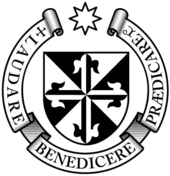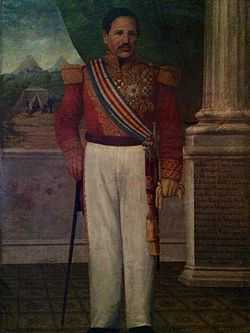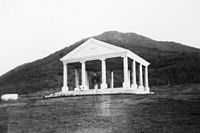Salamá
| Salamá | |
|---|---|
|
San Mateo church | |
 Salamá Location in Guatemala | |
| Coordinates: 15°06′N 90°16′W / 15.100°N 90.267°W | |
| Country |
|
| Department |
|
| Government | |
| • Mayor | Byron Tejeda (PP) |
| Population | |
| • Total | 40,000 |
| Climate | Aw |
Salamá is a city in Guatemala. It is the capital of the department of Baja Verapaz. It is situated at 940 m above sea level. The municipality of Salamá, for which the city of Salamá serves as the administrative centre, covers a total surface area of 776 km² and contains 40,000 people.
History

Salamá was settled as a doctrine by the Order of Preachers in the 1550s, as part of the Tezulutlán Capitulations that friar Bartolome de las Casas lobbied from the Crown. The friars had thousand of acres with hills, forest, a section of the plain and abundant water supply.[1] Both location and weather were ideal for vines; the characteristic soil and dried grass from the rest of the plain was replaced by vines thanks to a superb irrigation system the friars built inspired by the Romans.[1]
After the independence in 1821, the Central Ameran liberal criollos tried to remove the Catholic Church from power, along with the Guatemalan aristocrats of the Aycinena family.[2] By 1829, the liberal forces of general Francisco Morazán expelled both the aristocrats and the regular orders from Central America, including the Order of Preachers, one of the richest;[2] in Salamá, they had to left behind their monastery, church and vines which were confiscated by the Guatemalan State government,[1] but remained abandoned due to the political turmoil of the times.[3]
Battle of Salamá of 1839


In early 1838, Morazán's liberal forces were back in Guatemala after a peasant revolt had ousted Guatemalan governor Mariano Galvez. Morazán and his Guatemalan ally José Francisco Barrundia y Cepeda invaded Guatemalan soil and when they arrived to San Sur, the executed summarily Chúa Álvarez, general Rafael Carrera father-in-law, for Carrera was the revolt leader. Morazán's soldiers placed Álvarez head on top of a stick as a warning to Carrera's followers;[4] upon learning the news, both Carrera and his wife, Petrona Álvarez -who had left Guatemala City to face Morazán and were in Mataquescuintla- promised to avenge Chúa even after Morazán's death.[5] The liberals sent several envoys to try to meet with Carrera, but he did not want to talk to them -especially Barrundia, who was told that he should not try to come in to talk to Carrera if he wanted to remain alive-. After this, Morazán began a strong offensive, destroying every single town in his path, stealing their few belongings and forcing Carrera militants to hide in the mountains.[6]
Thinking that Carrera was completely defeated, Morazán and Barrundia went on to Guatemala City, where governor Valenzuela and the conservative criollos of the Aycinena family celebrated finally having a stron criollo leader like Morazán, who had defeated the despicable Carrera and his peasant revolt once and for all. The Guatemalan offered to sponsor any campaign that Morazán wanted at that point.[7] Morazán helped Los Altos and appointed Mariano Rivera Paz -close to the Aycinena family-; however he did not return the former aristocrats any of their confiscated possessions. In return, Juan José de Aycinena y Piñol, leader of the family voted in favor of dissolving the Central American Federation, thus forcing Morazán to return to El Salvador to try to save what was left of his presidential powers. On his way to El Salvador, he increased people repression, on anybody suspect of helping Carrera in the past.[8]
Knowing that Morazán was on his way to El Salvador, Carrera tried to take Salamá with the little forces that he still had left, but was defeated and even lost his brother Laureano in the battle. With only a handful of men he was able to escape, badly wounded, to Sanarate.[9] After a halfway recovery, Carrera had a few more battles where he won, but suffered considerable casualties.[10]
Finally, the liberal forces captured Carrera, but could not shoot him, because the Central American Federation was in turmoil and they needed the caudillo to keep the peasants in check. Morazán was forced to appoint him as commander in Mita.[11][12] Morazán would come to regret that decision, as Carrera would eventually defeat him in 1840, finishing the Honduran general run as the main political figure of Central America.[13]
As of 1850, the population was estimated to be 4,500.[14]
Miguel Enríquez and president Barillas in 1892


In 1892, president general Manuel Lisandro Barillas called for election. It was the first time a Guatemalan president had become tired of the office and it was also the first election in Guatemala that allowed the candidates to make propaganda in the local newspapers. [15] Among the candidates who ran for office were:
- Lorenzo Montúfar y Rivera: a well known a respected liberal intellectual. He was the only one of all candidates who made an engraving of his portrait to publish it in the newspapers and was accused of wasting resources for doing this.[15]
- General José María Reyna Barrios: nephew of former president Justo Rufino Barrios and eventual winner.
- Miguel Enríquez: a Salamá landowner. Enríquez had been a liberal, but became a conservative after the persecution that he suffered from the Barillas administration.
Barillas Bercian was unique among all liberal presidents of Guatemala between 1871 and 1944: he handed over power to his successor peacefully. When election time approached, he sent for the three Liberal candidates to ask them what their government plan would be. Satisfied with Reyna Barrios response, Barillas made sure a huge column of Quetzaltenango and Totonicapán Indigenous people came down from the mountains to vote for the general. The official agents did their job: Reyna was elected president[16] and, not to offend the losing candidates, Barillas gave them checks to cover the costs of their presidential campaigns. Reyna Barrios, of course, received nothing, but he went on to become President on March 15, 1892.[17]
Only Enríquez was not compensated; on the contrary, after the elections he had to run away from his farm land in Salamá after being accused of sedition; he was captured and executed near Zacapa.[15]
20th century




Festivals
The annual festival takes place from September 17 to September 22.
References
| Wikimedia Commons has media related to Salamá (Guatemala). |
- ↑ 1.0 1.1 1.2 Maudslay & Maudslay 1899, p. 107.
- ↑ 2.0 2.1 González Davison 2008, p. 4-15.
- ↑ Stephens & Catherwood 1854, p. 1.
- ↑ González Davison 2008, p. 84-85.
- ↑ González Davison 2008, p. 85.
- ↑ González Davison 2008, p. 86.
- ↑ González Davison 2008, p. 87.
- ↑ González Davison 2008, p. 89.
- ↑ González Davison 2008, p. 91-92.
- ↑ González Davison 2008, p. 92.
- ↑ Hernández de León 1959, p. April 20.
- ↑ González Davison 2008, p. 94.
- ↑ González Davison 2008, p. 98.
- ↑ Bailey 1850, p. 87.
- ↑ 15.0 15.1 15.2 Castellanos 2014, p. 40:00.
- ↑ De Los Ríos 1948, p. 82.
- ↑ De Los Ríos 1948, p. 79.
Bibliography
- Bailey, John (1850). Central America; Describing Each of the States of Guatemala, Honduras, Salvador, Nicaragua, and Costa Rica. London: Trelawney Saunders. p. 87.
- Castellanos, Lorena (2014). "Vida y obra de José María Reyna Barrios". Universidad Francisco Marroquín (in Spanish). Guatemala. Retrieved 3 November 2014.
- De los Ríos, Efraín (1948). Ombres contra Hombres (in Spanish) (2nd ed.). México: Fondo de la Cultura de la Universidad de México.
- Gleijeses, Piero (1992). Shattered hope: the Guatemalan revolution and the United States, 1944-1954. USA: Princeton University Press. ISBN 9780691025568.
- González Davison, Fernando (2008). La montaña infinita; Carrera, caudillo de Guatemala (in Spanish). Guatemala: Artemis y Edinter. ISBN 84-89452-81-4.
- Hernández de León, Federico (1959). "El capítulo de las efemérides". Diario La Hora (in Spanish) (Guatemala).
- Hernández de León, Federico (1930). El libro de las efemérides (in Spanish). Tomo III. Guatemala: Tipografía Sánchez y de Guise.
- Marroquín Rojas, Clemente (1952). "Los ricos con el agua al cuello". Impacto (in Spanish) (Guatemala).
- Marroquín Rojas, Clemente (February 1954). "El caso del diputado José Luis Arenas". La Hora (in Spanish) (Guatemala).
- Maudslay, Alfred Percival; Maudslay, Anne Cary (1899). A glimpse at Guatemala, and some notes on the ancient monuments of Central America. London, United Kingdom: John Murray.
- Stephens, John Lloyd; Catherwood, Frederick (1854). Incidents of travel in Central America, Chiapas, and Yucatan. London, United Kingdom: Arthur Hall, Virtue and Co.
External links
- Salama article - Guatemalan Tourism Committee (in Spanish)
Coordinates: 15°06′N 90°16′W / 15.100°N 90.267°W
| ||||||||||||
